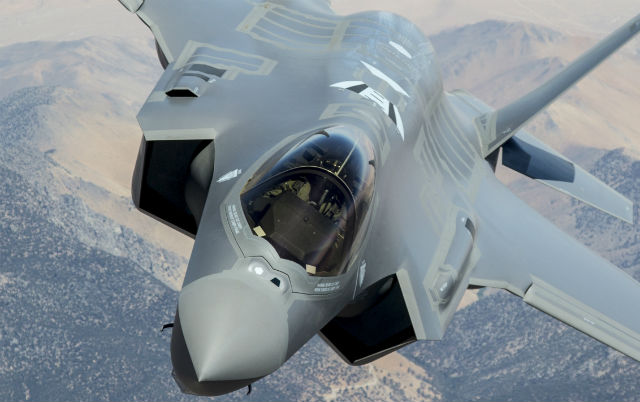A recent memo from the Pentagon’s top weapons tester throws cold water on the US Air Force’s initial operational capability announcement earlier this month, which declared the Lockheed Martin F-35A equipped with Block 3i software could provide basic capabilities.
Instead, the director of Operational Test and Evaluation argues in a scathing 9 August memo that many significant limitations remain on the aircraft.
“The program is actually not on a path toward success, but instead on a path toward failing to deliver the full Block 3F capabilities for which the Department is paying almost $400 billion by the scheduled end of System Development and Demonstration (SDD) in 2018,” Michael Gilmore writes. “If used in combat, the F-35 in the Block 3i configuration, which is equivalent in capabilities to Block 2B, will need support to locate and avoid modem threats, acquire targets, and engage formations of enemy fighter aircraft due to outstanding performance deficiencies and limited weapons carriage available.”
Meanwhile, the F-35 Joint Program Office remains confident that the capability gaps will be fixed on the aircraft in time and under the current budget parameters. In an email statement, Lt Gen Chris Bogdan, executive officer of the joint programme office, stated development and technical challenges are to be expected, but that the office is acting on DOT&E's recommendations. Lockheed Martin F-35 spokesman Mark Johnson concurred with the JPO, stating SDD will complete in late 2017.
"There were absolutely no surprises in the recent memo from the DOT&E," Bogdan says. "All of the issues mentioned are well-known to the F-35 JPO, the U.S. services, international partners and our industry team.The JPO continues to provide DOT&E with our full cooperation and unfettered access to information."
With the current Block 3i software, the F-35 has the capability of many legacy close air support platforms and may even be less effective than the current F-15E, F-16, F-18 and A-10 in a permissive environment, DOT&E states. If deployed to a combat zone today, the F-35A would require numerous workarounds. Due to issues with the aircraft’s Link-16 data-link messaging, some pilots reverted to voice communications over a radio to validate digital communications.
The F-35A is not able to use the 25mm GAU-22 internal cannon, for example, with Block 3i software. The next software upgrade, dubbed Block 3F, will provide softwarae to support gun testing. Unlike the fighters the F-35A replaces, the stealth fighter with Block 3i software lacks an automated targeting for tracking and targeting moving vehicles.
The programme is running out of time and money to deliver Block 3F before SDD concludes and new discoveries are only furthering the program’s Block 3F flight testing schedule, the memo states. Funding and maintenance personnel to support testing are also tenuous. A number of Block 3F capabilities have fallen behind including Small Diameter Bomb integration, MADL capability to share imagery and basic Link 16 that allows the aircraft to transmit and receive messages.

In the memo, DOT&E detailed over a dozen deficiencies that must still be addressed on Block 3i, but referred to hundreds of capability shortfalls that still remain in Block 3F, which is needed to reach full operational capability, according to the memo.
The F-35A's sensor fusion system is designed to blend inputs from multiple onboard and offboard sensors into a single picture presented to the pilot, but it still isn't working. Tracks on single airborne targets are "splitting" on the displays, as the fusion algorithms confuse single tracks with multiple targets. Some airborne tracks simply disappeared from the pilots' displays and could not be recalled, the memo states. The air force also identified other fusion issues in Block 3i including inconsistent or ineffective electronic warfare capabilities.
In March 2015, Bogdan acknowledged issues with multi-ship sensor fusion, but did not point to fusion troubles on individual aircraft.
Earlier this week, Lockheed lauded the recent completion of 12weapons delivery accuracy events, which were aided by the test fleet's new Block 3F software. But the Block 3F mission systems software required multiple corrections before delivery accuracy testing could begin, DOT&E notes.
“Despite DOT&E asking the program office for information on the extent to which these deficiencies exist in Block 3i, this information is apparently still unknown,” the memo states.
During a 3 August briefing on IOC with USAF’s head of Air Combat Command, Gen. Herbert Carlisle stated that issues related to the F-35’s debrief capability and post-mission creation would be addressed with software modifications. The ground data receptacle, the system used to transfer data from the portable memory device, has delayed post-mission debriefings, according to DOT&E. It took the GDR over a minute to decrypt each minute of video during a recent deployment to Mountain Home AFB, Idaho,, delaying post-mission debriefs by an hour.
“Although the program has developed a new GDR (version III) which has displayed faster decrypting times, certification problems have delayed fielding and the program is considering the need for another redesign,” the memo states.
In July, the USAF’s F-35A Integration Office identified policy issues as the biggest hurdle in sharing information across the nine partners and three foreign military sales customers participating in the Joint Strike Fighter Program. These mission data files, which are meant to be common across the US services and its allies, allow aircrews to make critical decisions, including identifying friend or foe.
But nagging technical shortfalls remain on the software tools used to develop and test the files, the memo states. Gilmore points out that the programme has yet to address significant deficiencies with the US Reprogramming Laboratory that have prevented mission data files testing.
“Key hardware upgrades needed to develop and verify Block 3F mission data files for detecting and identifying emissions from current threat systems are still not on contract, despite the requirement being identified and funding provided in 2012,” the memo states. “It will take at least two years after ordering the equipment, so the required equipment will not be in the lab in time to support MDF development for IOT&E.”
Source: FlightGlobal.com



















